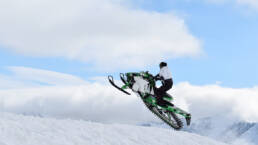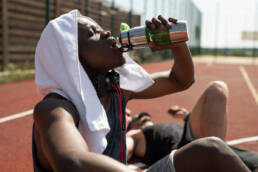As the ski season approaches, many of us get excited to hit the slopes for some fun in the snow. Whether you’re an expert skier or just starting out, there’s no denying that skiing and snow sports come with their own unique set of challenges for the body. Skiing places a lot of strain on various muscle groups, often leading to muscle tightness and fatigue, which can ultimately affect your performance on the slopes and your recovery. Fortunately, incorporating regular massage therapy into your routine can help alleviate muscle discomfort, improve mobility, and enhance your recovery between ski sessions. In this blog, we’ll dive into how skiing affects your muscles, offer injury prevention techniques for the slopes, and explain the many benefits of massage therapy in preparing your body for ski season and aiding recovery afterward.
Understanding Muscle Tightness and Fatigue in Skiing
Skiing is a full-body workout that demands strength, balance, and endurance. Your legs, core, and arms work together in dynamic movements as you navigate through the slopes, controlling your speed and direction. While skiing is an exhilarating sport, it also puts tremendous pressure on your muscles. Common muscle tightness and fatigue issues among skiers often occur in the quadriceps, calves, hamstrings, lower back, and shoulders.
Muscle Groups Affected by Skiing
Quadriceps: The quadriceps muscles in the front of your thighs bear much of the load during skiing. They are essential for controlling your speed and maintaining stability when bending your knees to absorb the impact of downhill motions. Prolonged skiing can lead to tight quads and sore muscles.
Hamstrings: Skiing requires a lot of bending, flexion, and extension of the legs, which engages the hamstrings in the back of your thighs. If these muscles aren’t properly conditioned or stretched, they can become tight and fatigued, leading to a decrease in mobility.
Calves: Skiing with your feet in ski boots can put stress on the calf muscles. The constant flexion and extension as you control your movements down the slopes can cause stiffness and soreness, especially after long days on the mountain.
Lower Back: Skiing often requires forward bending and twisting motions, which can put pressure on the lower back muscles. These movements, especially if done repeatedly without proper core support, can lead to tightness or even lower back pain.
Shoulders and Arms: Skiing also engages the upper body, particularly the shoulders and arms, for balance, pole usage, and maintaining a controlled posture. Skiers can develop tension in the shoulders, neck, and arms, particularly after a long day of skiing.
Fatigue and Recovery
After a day on the slopes, many skiers experience extreme muscle fatigue. The body can feel exhausted, and the muscles may become stiff and sore. This is often due to lactic acid buildup in the muscles, microtears in muscle fibers, and depletion of energy stores. It’s crucial to take steps to manage and alleviate muscle fatigue to prevent overuse injuries and ensure a quicker recovery time.
Techniques for Injury Prevention on the Slopes
Preventing injuries on the slopes is just as important as recovering from them. Skiing is inherently risky, but proper preparation and knowledge of the body’s movements can significantly reduce the chances of injury. Let’s explore a few essential techniques for injury prevention.
1. Proper Warm-Up Exercises Before Skiing
Before heading out for a day on the slopes, it’s crucial to warm up your muscles. A dynamic warm-up routine helps increase blood flow to the muscles and improves flexibility, which reduces the risk of injury.
- Leg Swings: Swing each leg forward and backward, keeping your upper body stable. This helps loosen up the hips, hamstrings, and quads.
- Lunges: Lunges stretch the hip flexors, quads, and glutes. Make sure your knee doesn’t extend past your toes as you lunge forward.
- Torso Twists: This exercise helps to stretch the core, lower back, and shoulders. Rotate your torso from side to side in a controlled manner.
2. Focus on Proper Form and Technique
Maintaining proper form while skiing can prevent unnecessary strain on your muscles. It’s important to stay balanced, keep your knees slightly bent, and maintain a forward-leaning stance to absorb shock effectively. Pay attention to your posture while skiing to avoid muscle fatigue and unnecessary injury.
- Keep your weight forward on your skis to avoid leaning back, which can stress your knees and lower back.
- Make sure your knees are aligned with your toes when turning or making sharp movements to avoid strain.
3. Choose the Right Equipment
Properly fitting ski boots, skis, and bindings play a significant role in injury prevention. If your boots are too tight or too loose, they can create unnecessary pressure on your muscles or cause discomfort. Ski poles should be at the right length to provide support without straining your arms. Wearing the proper protective gear, including a helmet and knee pads, can also help mitigate the impact of falls.
Benefits of Massage Therapy for Skiers
Massage therapy is a powerful tool for improving mobility and recovery, particularly for athletes. For skiers, regular massage can help address muscle tightness, reduce fatigue, improve flexibility, and speed up recovery time. Below are some key benefits of incorporating massage therapy into your ski routine:
1. Improved Circulation
Massage therapy improves blood flow to the muscles, which enhances the delivery of oxygen and nutrients to the muscles while also promoting the removal of waste products like lactic acid. This is particularly important after a long day of skiing, as it helps to speed up the recovery process.
2. Muscle Relaxation
Skiing can cause muscles to tighten and become sore. Deep tissue massage, sports massage, and other therapeutic techniques can help relax these tight muscles by breaking up adhesions and reducing muscle spasms. This allows the muscles to return to their normal range of motion, making it easier for you to perform the necessary movements on the slopes.
3. Reduced Inflammation and Pain
Massage therapy can also help reduce inflammation and pain caused by overuse, poor posture, or injuries sustained while skiing. Regular massage helps minimize the buildup of inflammation in the muscles, enabling you to feel better faster.
4. Increased Flexibility and Mobility
Skiing demands flexibility, particularly in the legs, hips, and lower back. Massage therapy helps to increase range of motion and flexibility in these areas, making it easier to perform complex movements while skiing. This improved mobility reduces the risk of strain and injury, helping you ski with greater ease.
5. Mental Relaxation
Skiing can be physically demanding, and the mental stress of staying focused on the slopes can take its toll. Massage therapy offers significant relaxation benefits, helping to reduce mental stress and promote a sense of well-being, which is just as important for performance and recovery.
Types of Massages Recommended for Skiers
Massage therapy is not one-size-fits-all. Different types of massages are tailored to specific needs and goals. For skiers, several types of massage can offer the greatest benefits:
1. Sports Massage
Sports massage focuses on reducing muscle tension and improving flexibility, making it ideal for skiers. This type of massage uses techniques like deep tissue, stretching, and friction to target problem areas and improve muscle function.
2. Deep Tissue Massage
Deep tissue massage targets the deeper layers of muscle tissue to address chronic muscle tightness and injuries. This is particularly useful for skiers who experience intense muscle fatigue or soreness after a long day on the slopes.
3. Trigger Point Therapy
Trigger point therapy focuses on specific areas of muscle tightness and discomfort. For skiers, this could mean working on areas like the calves, hamstrings, quads, and lower back, which tend to hold the most tension after skiing.
Preparing Your Body for Ski Season
In addition to regular massage therapy, preparing your body before hitting the slopes is crucial. Here are a few tips for getting ski-ready:
1. Off-Season Conditioning Exercises
Staying active in the off-season will help build strength and endurance in the muscles used for skiing. Incorporate exercises that target your quads, hamstrings, calves, core, and upper body, as these muscles are essential for skiing.
2. Flexibility and Strength Training
Skiing requires both flexibility and strength. Stretching exercises and yoga can improve flexibility, while strength training with weights or resistance bands will help build the muscle power needed to control your movements.
3. Nutrition for Endurance and Recovery
Eat a well-balanced diet rich in protein, healthy fats, and carbohydrates to fuel your body for skiing. Staying hydrated is also essential for muscle performance and recovery.
Post-Ski Season Recovery and Maintenance
After a long day on the slopes, your muscles need time to recover. Proper post-skiing care includes stretching, staying hydrated, and booking regular massage sessions to maintain flexibility and prevent stiffness. If you experience any injuries, early treatment and massage can help alleviate pain and speed up recovery.
Skiing is not only a fun and exhilarating way to enjoy the winter months, but it’s also a challenging sport that requires strength, endurance, and flexibility. Whether you’re carving through fresh powder, navigating moguls, or enjoying a leisurely run down the mountain, your body takes on a significant workload. Skiing demands a lot from your muscles—quads, hamstrings, calves, and core—and repetitive motion, cold temperatures, and altitude can lead to muscle tightness, fatigue, and soreness. If you’re not careful, these issues can quickly turn into injuries that sideline you from enjoying the slopes.
However, the good news is that with the right care and attention, you can avoid many of the common pitfalls that ski season brings. By addressing muscle tightness and fatigue through effective injury prevention techniques like proper warm-ups, good skiing form, and using the right equipment, you can lower your risk of injuries and ensure that your body stays in peak condition throughout the season. But there’s more you can do to maintain your body and keep your muscles at their best—massage therapy.
Massage therapy is an incredibly effective and often overlooked tool for skiers. It doesn’t just help with immediate muscle relief; it supports your body in long-term recovery and maintenance. The deep tissue, sports, and trigger point massages offered by professionals can target specific areas of tightness and muscle strain, helping to loosen up muscles, improve flexibility, and enhance overall circulation. This means that you’ll recover faster, get more out of your skiing experience, and ultimately perform better on the slopes.
Additionally, consistent massage therapy can help alleviate chronic tension and prevent muscle injuries before they start. It reduces the stiffness caused by long hours on the slopes and improves range of motion so that you’re able to maintain a smooth, efficient skiing technique. This is particularly important for skiers who regularly push their limits, as well as those who may experience pain or stiffness after a day on the mountain.
But massage therapy isn’t just about recovery. It’s a key component of maintaining peak performance. By increasing blood flow, reducing inflammation, and keeping your muscles pliable and flexible, massage therapy helps you get the most out of each day on the slopes. The improvement in mobility and flexibility means you can move more freely, make quicker adjustments, and enjoy skiing for longer periods without feeling weighed down by muscle tightness or discomfort.
Conclusion
Beyond the physical benefits, massage therapy also offers mental relaxation. Skiing requires concentration and focus, and after a long, intense day on the slopes, it’s important to give your mind a break. Massage helps reduce stress, release endorphins, and promote a sense of well-being, which is crucial for balancing the mental and physical demands of the sport.
By combining massage therapy with proper warm-ups, stretching, strengthening exercises, and nutrition, you’ll give yourself the best chance at enjoying a full, injury-free ski season. Regular massage doesn’t just help you recover—it actively prepares your body for the demands of the sport, allowing you to enjoy every run with less fatigue and discomfort. And let’s face it, a ski season free from pain means more time spent doing what you love on the slopes!
Whether you’re a competitive skier, a weekend enthusiast, or someone just trying to get back on the slopes after a long break, massage therapy should be a vital part of your winter sports routine. Not only will it help you recover faster, but it will also keep you skiing at your best, longer. Don’t let muscle tightness, fatigue, or injury keep you from enjoying the season—make massage therapy a priority.
So, if you’re ready to experience the benefits of massage therapy for your skiing performance and recovery, contact Denver Sports Massage today. Our trained therapists are here to help you stay in top condition throughout the ski season and beyond. Take care of your body, and your body will take care of you on the slopes.

With unique treatment plans tailored specifically to each individual, our goal is to offer a comprehensive approach to healing and reducing pain. We pride ourselves on taking a holistic approach to massage therapy for pain and are committed to providing the highest quality care. If you’re looking for a massage therapist in Denver to help with pain, schedule an appointment today!
Like this article? Spread the word!
Related Posts
April 15, 2025
Weekend Warriors, Beware: How to Bounce Back From Spring Sports Injuries
Weekend warriors, beware—spring injuries can sneak up fast. Learn how massage therapy…
February 15, 2025
The Ultimate Recovery Plan for Skiers and Snowboarders: Avoid Injuries This Winter
Stay injury-free this ski season with a tailored recovery plan! Discover how Denver…
January 15, 2025
Your Secret Weapon for Sticking to New Year’s Resolutions: Sports Massage for a Strong Start
Discover how Denver Sports Massage can help you stick to your New Year’s resolutions.…





